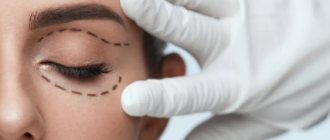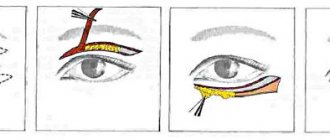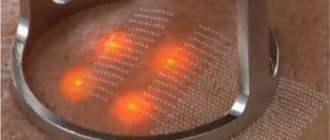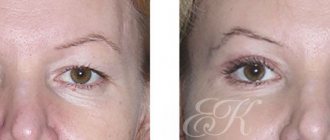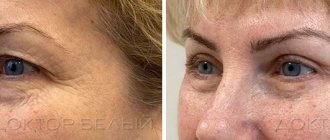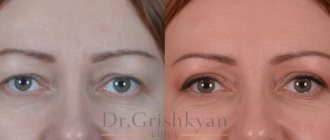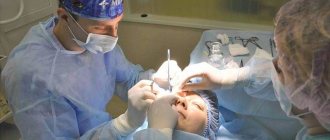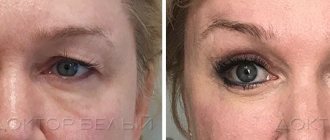Transconjunctival blepharoplasty
Are you bothered by nasolacrimal grooves, wrinkles or bags under your eyes? Procedures with a cosmetologist do not bring the desired results?
Then you should consider minor plastic surgery, transconjunctival eyelid surgery. Patients today often resort to this modern aesthetic intervention to combat age-related changes and prolong their youth.
A tired, painful look always adds extra age to a person, even if according to his passport he is still very young. Lifestyle, sleep and nutritional patterns affect our appearance, but there are cases when imperfections in the periorbital area are congenital. In this case, the patient has a choice: spend money on course procedures from a cosmetologist, trying to cope with these shortcomings using a non-surgical method, or opt for a truly effective solution - transconjunctival blepharoplasty.
BLEPHAROPLASTY AT THE PIROGOV CLINIC IS AN OPERATION IN THE BEST PLASTIC SURGERY CLINIC IN ST. PETERSBURG.
*according to the ratings of the portals “Doctor Peter” and “Fontanka.ru” in 2021. Read more.
Recovery
The procedure is low-traumatic. The rehabilitation period is a maximum of one to one and a half weeks. During this time the following may be present:
- Discomfortable sensations;
- Minor swelling of the eyes.
Recommendations for the patient after surgery:
- Wear sunglasses (for the first time after surgery);
- Avoid swimming pools, baths, saunas (for about 3 months);
- Do not wear contact lenses (for a month);
- Do not visit the solarium or take sunbathing (in the next 2-4 weeks);
- Minimize any physical activity (for a month).
Transconjunctival plastic surgery of the lower eyelids in Moscow | Operation technique and prices in the clinic of Professor S.N. Blokhin
Transconjunctival plastic surgery of the lower eyelids: features and advantages of the procedure. Performing transconjunctival plastic surgery of the lower eyelids by experienced plastic surgeons in Moscow. High quality result.
How does transconjunctival blepharoplasty differ from classic blepharoplasty?
As noted earlier, this operation differs from classical blepharoplasty in the localization of the access through which the plastic surgeon performs all manipulations. Thanks to this, transconjunctival blepharoplasty has the advantages of completely invisible scars and a shorter recovery period after surgery.
However, this method of lower blepharoplasty is not suitable for everyone: transconjunctival access helps in correcting mild age-related changes in the periorbital area. For example, if a patient has noticeable tissue ptosis or excess skin that requires excision, then the plastic surgeon will suggest performing a classic incision.
How is transconjunctival blepharoplasty performed?
In most cases, transconjunctival blepharoplasty uses a combination of local anesthesia and intravenous sedation. The surgeon makes an incision on the conjunctiva of the upper / lower eyelid (the eyeball is not affected in any way). Then, through the resulting transconjunctival access, the surgeon exposes the internal tissues, excises the fatty hernias and tightens the skin. Depending on the indications, correction of adipose tissue may mean both partial removal of fat and its redistribution. If necessary, stitches are applied.
Contraindications for surgery
Transconjunctival blepharoplasty, like most plastic surgeries, is performed under general anesthesia, so there are a number of contraindications that will make it impossible to perform the operation under this type of anesthesia.
If you have serious chronic diseases of internal organs, acute respiratory diseases, autoimmune diseases, bleeding disorders, pregnancy or breastfeeding, exacerbation of skin diseases in the eyelid area, then you may be denied surgery. We take an individual approach to each patient, so we consider a specific medical case in detail.
Process
The procedure is performed under general anesthesia and lasts from 20 to 40 minutes. The puncture is performed in the mucous membrane of the lower eyelid using a special instrument. No additional external incisions are needed. Removal of fatty tissue (“hernias under the eyes”) is carried out through a mini-incision.
After removing the fat, the specialist tightens the area of the microscopic incision with absorbable suture threads (they dissolve without a trace and on their own in a maximum of a week).
A complete refusal to use suture materials is allowed: the incision heals without them.
The patient remains in the hospital hospital for 1 day after surgery under the supervision of medical personnel.
Important! Scars of the mucous membrane resolve without leaving a trace. This allows you to resort to sutureless plastic surgery and traditional lower eyelid surgery again (if necessary).
Photo from personal archive
Preparing for surgery
In preparation for the operation, it is necessary to decide on the choice of a plastic surgeon and the clinic where the operation will take place. You should not try to save money and have surgery in little-known clinics, where the price may be lower than that of more well-known competitors.
Repeated intervention to correct the shortcomings of the first operation is always technically more difficult and not always fully effective, so you need to carefully choose a specialist.
After an in-person consultation and discussion of all the details of blepharoplasty, the plastic surgeon will set a date for the operation and a list of preoperative tests.
Rehabilitation period after transconjunctival blepharoplasty
Since transconjunctival blepharoplasty involves minimal tissue trauma, the operation is characterized by a shorter recovery period compared to classic eyelid surgery. On average, the period of primary rehabilitation is 10 - 15 days, during which time it is necessary to maintain hygiene of the operated area, do not expose it to sudden temperature changes and do not get it wet. After this period, you can use decorative cosmetics in consultation with your doctor. Swelling and small hematomas are a normal reaction of the body to the intervention and go away within a week; to speed up this process, it is recommended to sleep on your back on a high pillow.
Progress of the operation
According to the operating plan, the patient arrives at the clinic at the appointed time and waits in his hospital room. The anesthesiologist takes him to the operation and escorts him to the operating room, where everything is ready for the start of aesthetic intervention. During transconjunctival blepharoplasty, the plastic surgeon makes punctures on the inside of the eyelid, through which he performs the necessary manipulations: removing bags under the eyes, redistributing fat bags.
As a rule, sutures are not placed on the mucous membrane, but this is possible in some cases at the discretion of the doctor. For the first 6 hours, a special bandage is applied.
Seamless or traditional plastic – which option is preferable?
The doctor must choose the method of plastic surgery, taking into account the patient’s condition and the goals to be achieved by the intervention. Advantages of seamless plastic surgery:
- Relatively low morbidity;
- The results of the procedure are predictable;
- The risk of complications is low;
- The rehabilitation period during which the eyelids become swollen is up to one and a half weeks;
- There are no seams in the surgical access areas.
Transconjunctival plastic surgery of the lower eyelids guarantees the absence of stitches and scars.
Results of work
All works
ADVANTAGES OF EYELID CORRECTION THROUGH THE CONJUNCTIVA
Correction of the lower eyelids along the conjunctiva is an innovative method. Previously, a percutaneous incision (along the edge of the lower eyelid) was used to remove hernias, but the technique provoked a number of complications. Transconjunctival plastic surgery has rapidly and justifiably gained popularity among surgeons all over the world. Today this is the best way to get rid of signs of fatigue and signs of aging.
- It leaves no traces of intervention, since the incision is hidden on the mucous membrane of the lower eyelid.
- It really gets rid of hernias and does not mask the problem.
- Long-lasting effect that lasts for 7-10 years.
- Prevents the formation of deep wrinkles and further stretching of the skin under the eyes, which inevitably occurs as the defect grows.
- The risk of complications is minimized and practically reduced to zero (for example, retraction of the lower edge of the orbit, ectropion of the lower eyelid).
- Short rehabilitation period.
Photos “Before” and “After” by day
See more “Before” and “After” photos
Patients are very attracted to the prospect of improving their appearance without visible signs of surgery. But transconjunctival eyelid surgery has a rather limited range of indications:
- performed only on the lower eyelids
- suitable for young patients with good skin contraction
